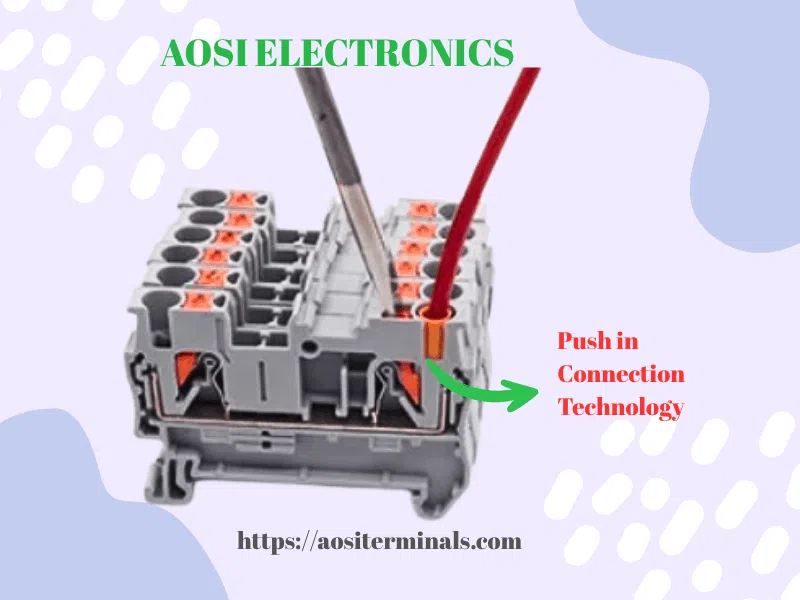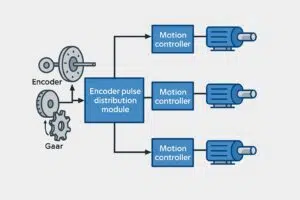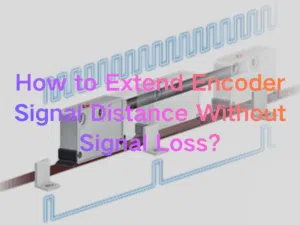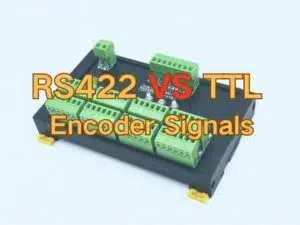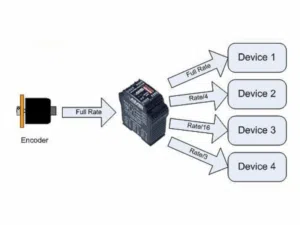Push-in connection technology has become increasingly popular in terminal blocks due to its efficiency and reliability in electrical wiring applications. In this article, we explore what push-in connection technology is, how it compares to spring cage terminals, its advantages, testing standards, and typical applications in industries such as industrial control and PLC systems.
What Is Push-in Connection?
Push-in connection technology allows conductors to be inserted directly into an open receptacle where an embedded flat spring clamp grips and secures the wire automatically. The spring mechanism bites into the conductor via a mechanical wedge action ensuring stable contact without the need for screws. This is sometimes also called push-fit or push-button connection.
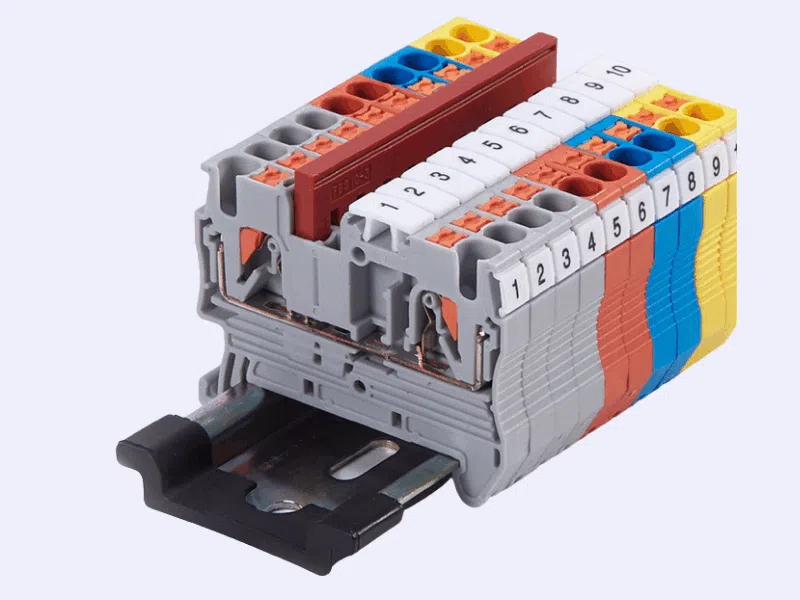
This design ensures:
- Gas-tight contact: prevents oxidation at the interface.
- Stable pressure: unaffected by vibration or temperature.
- Maintenance-free operation: no need for periodic re-tightening.
Push-in terminals are suitable for both solid conductors and ferruled stranded wires, ensuring universal compatibility across industrial environments.
The Difference Between Push-in and Spring Cage
While push-in and spring cage terminal blocks both utilize spring-loaded clamping to hold wires, the key difference lies in the release and insertion methods:
- Push-in terminals allow simple wire insertion without tools and usually feature release buttons or levers adjacent to the wire entry point for easy removal.
- Spring cage terminals often require a tool (such as a flathead screwdriver) to open the clamp for wire insertion or release because the spring forms an “a” shape inside the receptacle.
| Merkmal | Push-in Connection | Spring Cage Connection |
| Wiring Method | Direct wire insertion | Requires screwdriver to open clamp |
| Tools Needed | None | Yes (flat screwdriver) |
| Time Efficiency | Very high (up to 70% faster) | Mäßig |
| Wartung | Wartungsfrei | May require occasional re-tightening |
| Typische Verwendung | PLC control panels, compact modules | Power distribution terminals |
Push-in connection is essentially an optimized version of spring cage technology — designed for faster wiring and reduced operator fatigue during high-volume installations.
Kurz gesagt, push-in vs spring cage connection differs mainly in the need for tools — push-in terminals offer faster, maintenance-free performance.
Advantages of Push-in Technology
As a leading spring clamp wiring technology, push-in connection offers unmatched reliability and speed for industrial panels.
- Time and Labor Savings
Push-in terminals allow direct wire insertion without any tools.
This reduces installation time by up to 70% compared with screw terminals and by 50% compared with spring cage types.
- Reliability Under Vibration
The stainless spring maintains constant pressure on the conductor.
Even under strong vibration or temperature variation, the contact remains secure and stable, making push-in terminals ideal for industrial automation and transport systems.
- Compact and Modular Design
Push-in terminals are available in multi-level, pluggable, and modular configurations, allowing engineers to design space-saving panels while maintaining flexible wiring options.
- Maintenance-Free Operation
Because no screws loosen over time, inspection and service intervals are significantly reduced, lowering total ownership cost for control panel builders.
🔗 See also: Push-in vs Screw Terminal Blocks: Which Is Best for Your Panel?
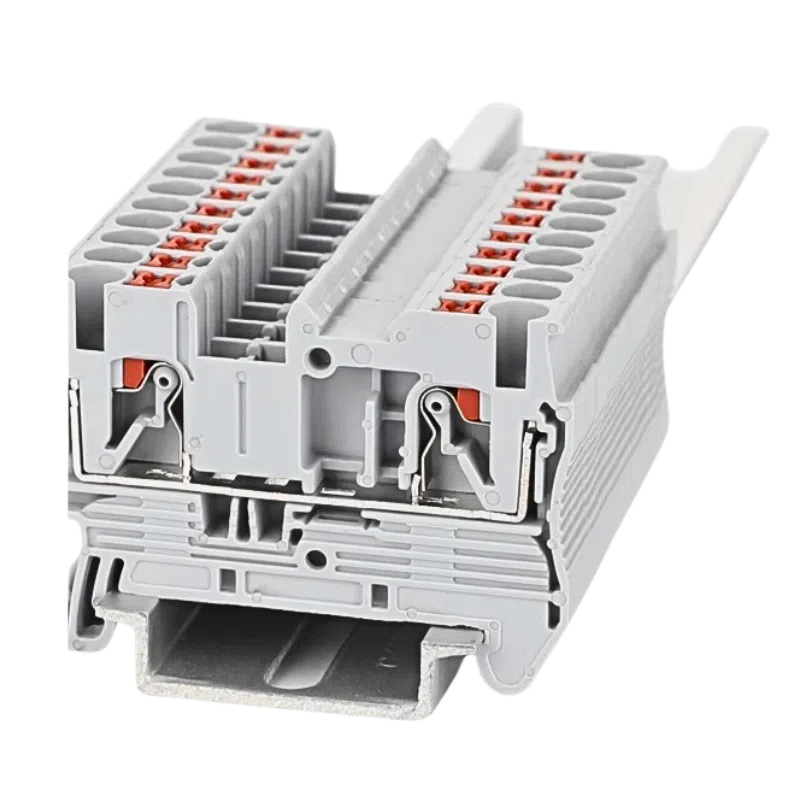
Push-in Terminal Block Series
- Experience the reliability of true push-in connection technology — fast, vibration-proof, and maintenance-free. UL & VDE certified models available for PLC and power systems.
Testing and Reliability Data
Engineers increasingly prefer push-in connection in terminal blocks for critical PLC and power distribution systems, where stable contact pressure is vital.
Push-in terminals undergo a series of rigorous international tests to ensure performance and durability:
| Test Type | Standard | Purpose |
| Pull-Out Force Test | IEC 60947-7-1 | Measures the retention strength of the conductor. |
| Vibration Test | IEC 60068-2-6 | Ensures contact stability under mechanical vibration. |
| Temperature Rise Test | UL 1059 | Verifies current-carrying capacity and heat dissipation. |
| Insulation Resistance Test | IEC 60947-1 | Confirms dielectric safety between terminals. |
Results from both Phoenix Kontakt und AOSI Elektronik show that push-in terminals maintain less than 1% resistance change even after 10,000 vibration cycles, proving long-term electrical stability.
Typical Applications
Push-in connection technology is widely applied in:
- Industrial automation: Control cabinets and PLC wiring utilize push-in terminals for compact, reliable connections.
- Power supply modules: Ensure secure power distribution with easy maintenance.
- Sensor/actuator wiring: Quick connection and replacement in sensor boxes and field devices.
Its application increases overall system reliability and simplifies maintenance procedures.
🔗 Related reading: Advantages of DIN Rail Push-in Terminal Blocks Over Other Types
FAQs – Push-In Connection Technology in Terminal Blocks
A1: Push-in technology relies on a stainless-steel spring clamp that presses the conductor against a current bar. When a solid or ferruled wire is inserted, the spring deflects and creates a constant, gas-tight pressure contact. This ensures stable conductivity, vibration resistance, and no need for re-tightening over time.
A2: Push-in terminals allow the wire to be inserted directly without tools, while spring cage terminals require a screwdriver to open the clamp before inserting the wire. Both use spring tension, but push-in terminals are faster to wire (up to 70% less time) and easier to maintain.
A3: Push-in terminal blocks are typically rated up to 800 V (IEC) und 600 V (UL), depending on pitch and wire size. For example, a 2.5 mm² model can handle up to 24 A, while larger versions like 6 mm² can reach 41 A.
A4: For stranded wires, ferrules are recommended because they ensure consistent insertion and prevent damage to individual strands. Solid conductors, however, can be inserted directly without ferrules. This recommendation aligns with IEC 60352-7 wiring requirements.
A5: Push-in terminals provide:
- Faster wiring without tools
- Consistent, vibration-proof contact pressure
- Compact multi-level designs for high-density panels
- Maintenance-free operation and long service life
A6: Yes, most push-in models use standard DIN rail dimensions and can replace screw terminals without redesigning the panel layout.
Schlussfolgerung
Push-in connection technology represents a major advancement in electrical terminal block design — offering faster installation, higher reliability, and lower maintenance.
By combining certified safety with vibration-proof performance, it has become the standard wiring solution in PLC, automation, and industrial power systems.
Explore the Push-in Terminal Block Series from AOSI Electronics for your next project, and experience true engineering efficiency.

